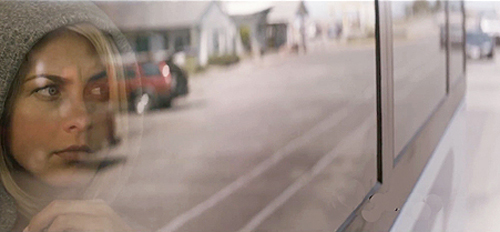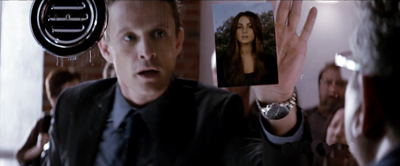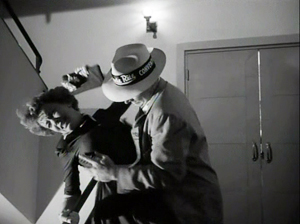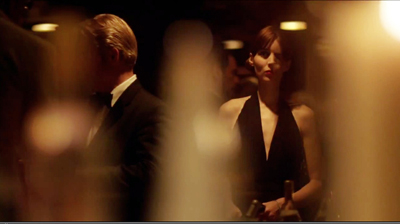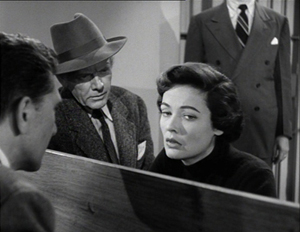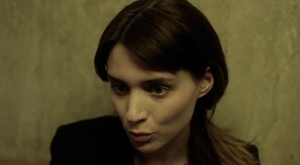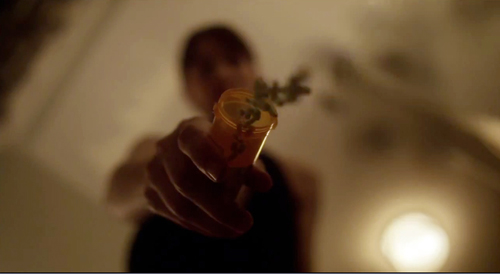SIDE EFFECTS and SAFE HAVEN: Out of the past
Sunday | March 24, 2013 open printable version
open printable version
Safe Haven; Side Effects.
DB here:
Occasionally someone will ask me how I watch a movie. Here’s a stab at an answer. If the film presents a story, fictional or nonfictional, I try to get engaged by it, as most viewers do. I also try to watch for how the filmmaker shapes sounds and images. Such things are hard to analyze on the fly, but we can at least be shot-conscious. I suppose as well there’s a small part of me asking whether what I’m watching is good or bad. Another part takes notice of what many viewers spot today: the sorts of story roles allotted to women and members of minorities.
At the same time, one module in my head seems to be looking for historical precedents and parallels to what I’m seeing. The purpose isn’t to dismiss current movies with “Aw, this has been done long ago.” Instead, I think I’m looking for ways in which earlier forms and styles are accepted, recast, or rejected by the creative choices being made today.
For instance, as I was watching Safe Haven and Side Effects, I was thinking of the 1940s.
Not that other periods haven’t left their traces. Both movies depend on crosscutting, something that goes back to the 1910s, as does the goal-oriented protagonist. Both rely as well on analytical editing, with Soderbergh in his usual spare way minimizing establishing shots in favor of compact constructive editing. The wobbly handheld shots cropping up in both films hark back to the 1960s and filmmakers’ periodic revival of them. Four-part structure: check. Rule of three: check. And so on.
But what popped out at me was something that I’ve noticed before. Films of the last twenty years or so borrow a lot of storytelling strategies that originated in the 1940s and carried through into the early 1950s.
In The Way Hollywood Tells It, I argued that 1990s Hollywood drew upon this heritage and in some ways pushed it farther. It isn’t just neo-noirs like Reservoir Dogs and Memento that owe a debt to the earlier period. Lots of films in many genres now casually use flashbacks, voice-overs, restricted points of view, multiple protagonists, network narratives, and replays of scenes from different perspectives—all strategies pioneered or consolidated in the 1940s. These techniques have become so accepted a part of mainstream moviemaking that we may forget that a comedy like The Hangover or a prestige drama like The Iron Lady presents fairly elaborate time schemes or tricks of character subjectivity.
We also tend to ignore the sheer eccentricity of the period. The 1940s introduced movies letting a house tell the story or embedding flashbacks within flashbacks within flashbacks. Characters dreamed things that came true, or realized that they were actually dead. Sometimes dead people narrated the story. All in all, things got pretty strange.
Part of that era’s legacy is the suspense thriller as we know it. I’ll be putting up a web essay on the development of the genre soon, but for now consider these two recent releases as heirs of that tradition. Of course there are big spoilers ahead.
Spooked
Like many 1940s thrillers, Safe Haven centers on a woman in peril. Most often the heroine is trapped in a house, and an unseen force or a ruthless husband is trying to kill or incapacitate her. The prototype is Gaslight (1944), where as often happens, the wife is rescued by a “helper male,” a romantic alternative to the husband. Variants of this plot include The Spiral Staircase (1946) and The Two Mrs. Carrolls (1947). This sort of domestic thriller, sometimes called a Gothic, tends to fill household spaces and everyday routines with vague threats.
Instead of confining its protagonist, Safe Haven builds its plot around a woman who has left home behind. Fleeing an abusive marriage, Erin arrives in a North Carolina town and slowly enters a love affair with Alex, a widower who runs a convenience store. Meanwhile her husband Kevin tries to track her down. The fairly conventional budding romance, as Erin joins Alex and his kids in forming a new family, is threatened by the prospect of Kevin finding her and dragging her back home. As a policeman, Kevin has unusual forces at his disposal: a crucial turning point is his putting out an unauthorized wanted poster. Not only does this endanger Erin’s new identity, but when Alex sees the poster, he breaks off their affair.
On-the-run plots are usually the province of male-centered thrillers like The 39 Steps and North by Northwest. It isn’t unknown, though, to make the woman a moving target. One of my favorites is Double Jeopardy (1999), in which Ashley Judd plays a wife convicted of her husband’s murder. When she learns that he faked his death, she realizes that she can’t be tried again for killing him. Released on parole, she pursues him, while her tenacious parole officer pursues her. An older example is Woman in Hiding (1949), in which Ida Lupino plays a wife who is supposedly murdered by her husband. Actually, she eludes death and tries to flee him, but he, discovering she’s still alive, catches up with her on a hotel staircase.
In such thrillers, there are two common ways you can generate suspense. Both depend on range of knowledge, as Alfred Hitchcock pointed out in 1947.
The author may let both reader and character share the knowledge of the nature of the dangers which threaten. . . . Sometimes, however, the reader alone may realize that peril is in the offing, and watch the characters moving to meet it in blissful ignorance and disquieting unconcern.
That is, the narration can attach us to a character and limit our knowledge to what she knows. Examples of this are Hitchcock’s Rebecca (1940) and Suspicion (1941), which quite strictly confine us to the heroine’s range of knowledge.
Safe Haven, like Woman in Hiding, takes the alternative option: omniscience, or what Hitchcock calls “sharing the knowledge of the dangers.” Crosscut scenes show Erin in Southport while Kevin follows her trail. Other crosscut scenes introduce us to Alex’s problems of raising his kids and grieving for his wife.
As Erin gradually settles into the community, we know that Kevin is closing in. He arrives during a town celebration, and the crosscutting becomes tighter. Thanks to Kevin, the store catches fire and endangers Alex’s daughter, while Kevin drunkenly wrestles with Erin at gunpoint.
Suspense and mystery go hand in hand, and suspense films have a habit of suppressing information about past events. Woman in Hiding begins with the wife’s car plunging into the river; later we get a flashback explaining what led up to the accident. Safe Haven begins with a black-haired woman hysterically running out of a house and taking refuge with a neighbor. What has led to this? The woman, now a blonde, then boards a bus, while we see a man with police credentials questioning witnesses and stopping other buses.
The plot is organized so that we don’t know for quite some time why Erin is being pursued by this exceptionally zealous detective. And some fragmentary flashbacks, mostly in the form of dreams (a favorite 40s device), hint that she has killed a man. Gradually, however, there are hints that this cop isn’t what he seems. Not until the end of the third part (circa 80:00) do we learn from a full flashback that the cop is her husband. Kevin is a crazed alcoholic who began to strangle Erin one evening; she stabbed him and fled her home. The teasing flashbacks, along with the suggestion that Kevin’s pursuit is an official inquiry rather than a private vendetta, misled us. What we saw at the start was Erin escaping from an abusive marriage.
A lower-key form of delayed and distributed exposition involves Alex and his kids. Instead of filling us in immediately on Alex’s life with his wife, we learn of their married life gradually. After Alex has fallen in love with Erin, he retreats to a room kept in memory of his dead wife. He riffles through letters she left behind, to be given to Josh and Lexie when they grow up. Later, Alex abandons Erin because of the wanted poster, and he retreats to his wife’s room, where he has a change of heart and goes to bring her into the home.
Why the change of heart? An unusual aspect of Safe House is the injection of, ah, otherworldly intervention. While living in her cabin, Erin meets a neighbor, Jo, who encourages her to get to know Alex. In the epilogue, Alex gives Erin one of the letters from his wife’s desk, labeled simply, “To Her.” It’s a sympathetic message expressing the wife’s support for the next woman to be wife and mother to her family. The picture inside is of Jo. Earlier, in the sacred space of Jo’s room, Alex seems to grasp that he has to reunite with Erin. At the climax, Erin, dreams that Jo is warning her that Kevin has caught up with her. As angel, ghost, or spirit—you choose—Jo has brought everyone together.
Reviewers, in this cynical age, scoffed at this device. I didn’t mind it because I liked its tie to tradition. Ghosts and angels have haunted American cinema from the start, but in the 1940s they played very prominent roles—not just in comedies like Topper Returns (1941) but in dramas. Beyond Tomorrow (1940), Our Town (1940), Happy Land (1943), A Guy Named Joe (1943), The Uninvited (1944), It’s a Wonderful Life (1947), and many other films unashamedly introduced supernatural beings as moral guides to the living. True, those films build their spooks into the premises of the plot early on, while Safe Haven saves its for a Big Reveal. But after The Sixth Sense (1999), this sort of twist shouldn’t seem too upsetting. (A second viewing reveals that Jo is unnaturally disturbed when it looks like Erin won’t bond with the family, and a few lines of dialogue take on new meanings when you know that Jo is dead.) Perhaps the gimmick seems wimpier when it’s invoked in a romantic thriller than in a masculine investigation plot.
Recommended dosage
Steven Soderbergh is one of our most exploratory directors, a filmmaker who tries different things without making a big deal about it. He’s also a cinephile who, like Cameron Crowe, admires and quietly adapts classic studio traditions. He turns out lots of movies, a habit reminiscent of the contract director of yore.
I was skeptical of his pastiche The Good German (2006), but I do admire his compact, unfussy direction, as I mentioned here. I’m a big fan of Out of Sight (1998), and I think his last batch of films, from Contagion (2011) through Haywire (2012) and Magic Mike (2012), shows him to be a director whose every project is solid and intriguing. It’s a pity he’s announced his retirement after the upcoming Liberace project.
I doubt that in Safe Haven Lasse Hallström was consciously channeling 1940s suspense thrillers, but it seems likely that Soderbergh was trying his hand at something deliberately Hitchcockian. (Reviewers needed no nudging to make the comparison.) Beyond comparisons with the Master of Suspense, Side Effects’s debt extends to two plot patterns of the 1940-early 1950s that Scott Z. Burns’s script ingeniously combines.
The first is what I call the Crazy Lady plot. The Snake Pit (1948) is probably the clearest example, but there are many others, including Bewitched (1945), Dark Mirror (1946), The Locket (1946), Shock (1946), Possessed (1947), and Whirlpool (1950). The plot pattern can be found in literary thrillers too, such as Margaret Millar’s The Iron Gates (1945) and John Franklin Bardin’s fine Devil Take the Blue-Tail Fly (1948). Hitchcock didn’t tackle a Crazy Lady plot until Marnie (1964), but in the 1940s he tried a Crazy Gentleman variation in Spellbound (1945).
In such films, the woman is the mystery. What is wrong with her? Why do her problems have such horrible consequences for her and others? Often the woman displays an abnormal division in her mind: the prospect of a split personality is never far off. The key factor is that her behavior is inconsistent. A rich woman shoplifts (Whirlpool), a sweet girl fatally stabs her fiancé (Bewitched). Accordingly, only a psychoanalyst can probe the sick woman’s behavior and track down the founding trauma, typically something that happened in childhood. A crucial convention is the scene in which the woman breaks through and realizes what ails her, as in this moment from Whirlpool. It’s typical of this plot that therapeutic dialogue is often paralleled by police questioning.
Side Effects gives the Crazy Lady’s mental problems a modern spin. Emily is suffering from depression, and her husband Martin’s recent release from prison hasn’t helped her recover. After ramming her car into a parking-garage wall, she’s cared for by Jonathan, a hospital psychiatrist also in private practice. He starts her on antidepressants, eventually giving her one recommended by Emily’s previous psychiatrist, Victoria. This seems to help, although it induces Emily to sleepwalk. While she’s apparently sleepwalking, she stabs Martin to death.
Now Jonathan is in a bind. If the drug Ablixa has been misprescribed, Jonathan is responsible for Martin’s death and Emily’s fate. Jonathan defends Emily and his testimony helps win a verdict of not guilty by reason of insanity. He continues to supervise her recovery while his career collapses. His patients abandon him, his partners cast him out of their business, and he’s dropped from a lucrative experiment. He’s also being investigated by his professional association.
In other words, Jonathan is now fulfilling a second 1940s plot pattern: The innocent man trapped by circumstance. He might be a murder suspect (Stranger on the Third Floor, 1940; Phantom Lady, 1944; The Big Clock, 1948) or an ordinary guy dropped into international intrigue (Journey into Fear, 1943; The Ministry of Fear, 1944). Side Effects combines this noirish convention with the Crazy Lady plot. It turns out that Emily and Victoria have conspired to set up Martin’s death. Emily actually hates her husband, and she’s learned enough from his insider-trading schemes to understand that a scandal could drive down Ablixa’s stock price. She and Victoria, who have become lovers, can make millions as a result of the murder.
Yet suspecting all this doesn’t help Jonathan. Emily can’t be tried again, and as Jonathan begins to grasp their scheme, Victoria draws the net tighter around him. She sends his wife faked photos suggesting that he and Emily have had an affair.
In 1947, novelist Mitchell Wilson pointed out an important convention of the thriller. He claimed that the defining feature of the genre was a fear felt by the protagonist that is communicated to the reader: the protagonist is in continual danger. But when the threat reaches its peak, the worm must turn.
The framework of the suspense story is the continual struggle of the frightened protagonist to fight back and save himself in spite of his pervading anxiety, and in this respect he is truly heroic. The action of the story does not consist in mere activity, but in the hero’s change of mood in response to changing circumstances.
Jonathan’s desperation leads him to concoct a scam of his own. Since Emily is in prison and can’t communicate with Victoria, he is able to play them off against one another. Holding a physician’s control over Emily, he can convince her to double-cross Victoria and unmask her. Then he double-crosses Emily and consigns her to the asylum while returning to his family.
Again, I’ve ironed out the ups and downs of the film in order to lay out the plot’s design. In the actual telling, we’re attached first to Emily and then more closely to Jonathan. The overall pattern resembles that of Whirlpool, which concentrates first on the way the wife’s kleptomania draws her to the sinister therapist Korvo, and then shifts to the investigation undertaken by the police and her husband, a psychoanalyst. (Whirlpool, like Side Effects, centers on dueling shrinks.)
Here the Crazy Lady premise is a masquerade, and Soderbergh “plays fair” with us about it. The 1940s films rely on mental subjectivity—voice-over inner monologues, exaggerated sound effects, hallucinations, dream imagery—in order to show that the protagonist is truly wacko. Side Effects presents Emily objectively, relying on somber color schemes, top lighting, and Rooney Mara’s morose demeanor to suggest a young woman struggling against depression.
From the outside we watch Emily’s glum visits to Martin in prison, their frustrated sex when he gets out, her impassive crashing of her car, her confiding in her boss, and her breakdown at a cocktail party. There are a few optical POV shots, but those are justified as Emily’s numb stare–although Soderbergh does sneak past us a POV shot that, because of distorting glass, might seem to be projecting Emily’s state of mind expressionistically. (See above.) Virtually everything we see suggests a woman losing control, so that when Emily perks up after going on Ablixa, we, like Jonathan and Martin, think she’s recovering.
Safe Haven leads us to jump to a conclusion—that the cop pursuing Erin is doing so legitimately—only to rescind that by filling out the teasing fragmentary flashbacks. Side Effects does something similar, but through simple ellipsis. The plot lets us think that Emily is genuinely depressed by skipping over things it could have shown, such as her fake vomiting or her dumping the prescription pills down the toilet. Only at the climax, when Jonathan wrings the truth from Emily, do we get subjective imagery. There are artificially sun-sprayed flashbacks of her days with Martin just before his arrest, as well as glimpses of her therapy with Victoria, followed by replays of the suicide attempts, now revealed as faked.
The 1940s popularized this sort of filling-in flashback, in which a replay shows items that were left out of an earlier presentation. The most famous example is the return to the opening of Mildred Pierce (1945). Now as then, we can’t completely trust a thriller’s narration. There are mysteries in the story, but there are also mysteries in the storytelling. No matter how much a thriller seems to tell us, key information is usually held back, and the suppression won’t always be signaled. To get Rumsfeldian: there are always known unknowns, but thrillers trade in unknown unknowns, data we didn’t realize were there.
There’s a lot more to say about these movies. For example, both trade on a premise common to the 1940s and American movies thereafter. Call it the Margaritaville Rule: There’s a woman to blame. Erin brings calamity to Southport and trauma to her would-be family, and Jonathan’s travails are the result of two scheming women, seconded by a hard-edged wife who won’t hear out his explanations.
Moreover, I hope it’s clear that I don’t think these two recent releases are merely cloning 1940s conventions. They incorporate subjects and themes of our time, like spousal abuse and the insidious power of Big Pharma. They exhibit some innovative plotting, such as the revelation of a guiding spirit in Safe Haven and the combination of Crazy Lady premises with the Cornered Innocent in Side Effects. And Soderbergh’s offers an exercise in crisp direction, from its conventional opening shot to its grimly symmetrical closing one.
My point is simple: However new our films may seem, whether they’re accomplished (Side Effects) or banal (Safe Haven), in important respects they’re continuing traditions that go back decades.
Why then, you may ask, do so many academics and journalists insist that classical cinematic storytelling is dead? Why do they so resolutely ignore the evidence of continuity between today’s films and those that went before? That’s a mystery I can’t solve.
Hitchcock’s remark about the range of knowledge and suspense comes from “Introduction: The Quality of Suspense,” Alfred Hitchcock’s Fireside Book of Suspense (New York: Simon and Schuster, 1947), viii. Mitchell Wilson’s remarks on fighting back are in “The Suspense Story,” The Writer 60, 1(January 1947), 16. His novel None So Blind (1945) became the Renoir film Woman on the Beach (1947).
The idea of the “helper male” in the Gothic is developed by Diane Waldman in “’At last I can tell it to someone!’: Feminine Point of View and Subjectivity in the Gothic Romance Film of the 1940s,” Cinema Journal 23,2 (Winter 1984), 29-40.
For more background on the 1940s thriller, see the web essay, “Murder Culture: Adventures in 1940s Suspense” and this blog entry. Another blog entry discusses replays in 1940s and 1950s American film. For more arguments about the debts of today’s films to studio Hollywood, see The Way Hollywood Tells It and other entries on this site. I analyze the duplicitous opening of Mildred Pierce, along with its revelatory replay, in this entry and its accompanying video.
Today’s entry neglects another important component of Side Effects: the music. For that, see Roger Ebert’s acute review. Expressive scores are, needless to say, central to 40s thrillers too.
Mike Grost’s encyclopedic website supplies a great deal of information about the mystery genre.
Side Effects.
P. S. 24 March 2013: Thanks to Gabe Klinger for correcting a dumb date mistake!












